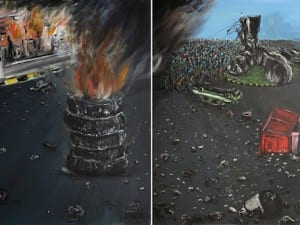A new cultural hub brings the latest developments in Japanese art, design and technology to the heart of London; Japan House on Kensington High Street launches its programme with a showcase for one of today’s most innovative architectural figures. Hokkaido-born Sou Fujimoto (b. 1971) will perhaps be best known to UK audiences for his creation of the 2013 Serpentine Gallery Pavilion in London, in which an impressive structure used the most basic forms and materials, taking on an ethereal and cloud-like quality. A three-dimensional grid of white-painted steel and glass resembled an architect’s drawing come to life
.
Fujimoto takes inspiration from an early love of exploring the natural landscape, with the idea of the forest and the cave becoming key preoccupations and recurring figures in his work. The structures are often open frameworks permeated by natural spaces, reconfigurable around the user’s evolving and changing needs. Various renowned projects such as Final Wooden House and House N (both 2008) create overlapping domains that blur the distinction between inside and outside, and offer multi-level environments inspired as much by trees or climbing frames as by design convention. A graduate of the University of Tokyo, he established his practice in 2000, with major institutional commissions that include the Musashino Art University Museum and Library in Tokyo (2010).
The Japan House show is unique in that it not only features current projects by Fujimoto but also looks at structural experiments and potential directions, asking the visitor to share in imagining a variety of possible ideas and spaces for an ever-changing landscape. Fujimoto explains the notion of potential through the wider relevance of the exhibition’s title: “Creating architecture is like planting seeds. When we design, we pay close attention to the context of the site, the requests of our clients and the cultural and historical backgrounds of each local community. Our dialogues with a variety of such factors inspire us to create actual places. In other words, it might be the kind of work to give forms to latent possibilities that remain hidden in the real society. Therefore, if what we call ‘future’ is defined as a series of manifestation of possibilities, I would say that small proposals that stimulate them are ‘seeds of the future.’”

The show also considers Fujimoto’s fundamental concept of “found architecture”, his belief that new possibilities are already all around us, embedded within the forms of everyday objects, awaiting discovery. He notes: “Architecture, I think, is something that is first found and then made. Just as our ancestors find their habitat in caves and woods, in modern times we discover ours amongst the many things we encounter in this immense built jungle. And it is a discovery like this that leads us to conceiving new projects.”
Sou Fujimoto: Futures of the Future runs at Japan House, London Until 5 August. www.japanhouselondon.uk
Credits:
1. Sou Fujimoto, L’Arbre Blanc.
2. Serpentine Gallery Pavilion 2013, Designed by Sou Fujimoto © Sou Fujimoto Architects, Image © 2013 Iwan Baan.
3. Sou Fujimoto, L’Arbre Blanc.





